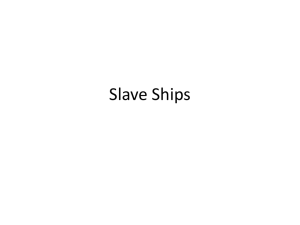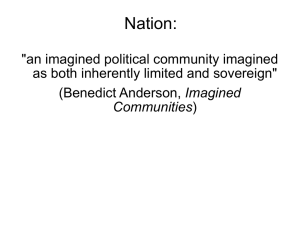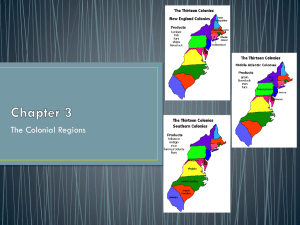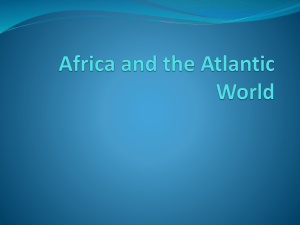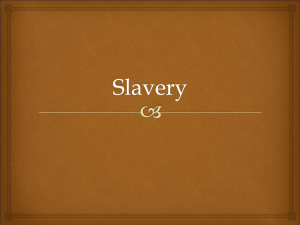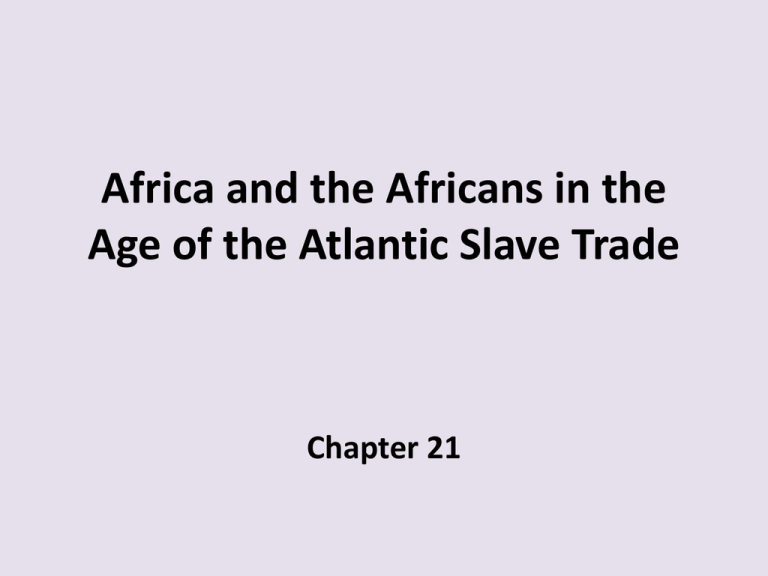
Africa and the Africans in the
Age of the Atlantic Slave Trade
Chapter 21
An Overview of Section 4-5: Africa
Africans are forcibly removed from Africa
African culture plays an important role in the development of
American civilizations
Islam consolidated its position in sub-Saharan and east Africa
Most of Africa remains independent states
Portuguese 1st Europeans in Africa (1400s)
• Portuguese set up forts along African coast to
trade (these forts were called factories)
• Factories allowed them to trade w/out needing
many Portuguese people there
• Portugal allied w/local rulers who allowed
factories in return for Portuguese products and
protection
El Mina
• Most important Portuguese trading factory
• Built 1482 in West African forest where gold was
Portuguese Take Over Existing Trade Routes
• For example, they traded with Mali and Songhay
• Portuguese traded along the Gold Coast
(specifically kingdom of Benin)
Portuguese Work to Convert African Rulers
• Nzinga Mvemba (1507-1543) = Ruler of Kongo,
Portuguese converted him and entire kingdom
and Mvemba tried to “Europeanize” his people
Luanda
• Portuguese factory south of Kongo
• Start of Portuguese control of Angola
Not Just Slaves, But Mostly Slaves
• Portugal interested in Africa for gold, pepper,
and other resources, but also slavery
• Portuguese began importing slaves from
Africa in 1400s
• Europeans mostly got slaves by trading for
them from local African rulers
Sugar Plantations = Slavery!
• Slave trade expanded greatly when Spain and
Portugal established sugar plantations on islands
they owned in the Atlantic and then in America
• By 1600, the major form of commerce in Africa
was the slave trade
• From 1450 to 1850, 12 million Africans shipped
across Atlantic to Americas as slaves
• Needed a lot of slaves b/c so many died and low
birth rates (not as many women brought in)
• 42% of all slaves went to Brazil (largest of any
area in the Americas)
Demographic Patterns
• Most slaves shipped across Atlantic were men
(planters in America wanted men to do work)
• African societies lacked men, and populations
were lower than they would have w/no slave
trade
• New foods from the Americas (like maize)
introduced to Africa through slave trade
1. The first European nation to visit
and to exploit Africa was
a) Spain
b) Portugal
c) France
d) England
2. Portuguese missionaries were most
successful on their activities in
a) Morocco
b) Benin
c) Ghana
d) Kongo
3. The European slave trade out of
Africa arose and expanded when
a) Europeans began supplying Muslim slave markets in the
Middle East
b) Europe conquered the coasts of West Africa
c) Gold was discovered in Iberia necessitating greater
numbers of laborers
d) Sugar plantations were established were established on
the Atlantic islands and in the Americas
4. The large numbers and high volume of
Africans in the slave trade was necessary
because
a) Most Africans escaped from slavery before arriving
b) The mortality of slaves was high and their fertility
rate was low
c) African slaves were also needed on estates in
Europe after the black death
d) European slavers also supplied Muslim and Asian
markets
5. Most slaves transported out of
Africa went
a) To the Muslim states of the Red Sea
b) Across the Sahara to north Africa
c) Across the Atlantic to the Americas
d) To Europe
6. The largest number of African slaves
sent to the Americas went to
a) British and French islands of the Caribbean
b) Brazil
c) The slave states of the United States
d) The Spanish colonies along the Pacific coast
Enter the Dutch, English, and French
• Early on, Portugal controlled slave
trade, but after 1630, other
Europeans got involved
• Dutch, British and French got
involved
• The British began the Royal African
Company to run their slave trade
Europeans Copy Portuguese Model
• Europeans set up factories along coast and allied
with local rulers (gave gifts in return for slaves)
• Indies pieces – name Spanish used for male
slaves, which were valued much higher than
women or children
Slaves Valuable to European Economy
• Slavery was important to European economy –
slaves used on plantations in their colonies
• Triangular Trade = Trade that linked Africa,
America, and Europe (slaves to America; sugar,
tobacco to Europe; European goods sent to
Africa) – see next slide for map
• Slave trade helped contribute to the growth of
capitalism (people profited off the trade)
African Enslaved Africans
• Slavery existed in Africa before the Europeans
• Africans enslaved many women, and rulers had
large harems, reducing status of women
• Slave trade intensified and expanded when
Europeans arrived
Europeans Tap Into Existing Slave Trade
• Europeans able to gain slaves quickly b/c they
were able to control already existing slave trade
routes
• African rulers of large, centralized states enslaved
their neighbors, and traded them to Europeans
Slavery and African Politics
• Europeans set up factories (forts) along coast of
Africa to trade slaves
• The most powerful African states became the ones
located just inside the coast which could get
firearms from Europeans and use them to go inland
and capture more slaves to trade to the Europeans
• As result of slave trade, constant wars occurred in
Africa as these states competed to gain slaves
Asante (Ashanti)
• Example of empire just inside
African Coast (along the Gold
Coast) that rose through the
slave trade
• Began in 1651 by the Oyoko clan
of the Akan people
• Used firearms from Europeans to
capture and trade slaves to the
Europeans
Dahomey
• Another example of empire just
inside African coast that rose
through the slave trade
• Like Asante, these African societies
creative in the arts (bronze-casting,
woodcarving, and weaving
flourished)
• Best artisans worked for the rulers,
and their art honored the rulers,
and had religious overtones
East Africa and the Sudan
• East coast of Africa (Swahili Coast) not as much
affected by trans-Atlantic slave trade
• States continued commerce in Indian Ocean,
though now Portuguese and Ottomans involved
• Majority of slaves from east coast sent to Arabia
and Middle East
The Interior of East Africa
• Not as much known about this
region at the time b/c had little
contact with outside world
• Movement to spread Islam
occurred beginning in 1770s
along northern savanna
• Fulani = pastoral people of
western Sudan who established
an Islamic state
7. The slave trade out of Africa was
controlled by
a) African trading guilds
b) European slave traders and African rulers
working jointly
c) Muslim traders
d) The Europeans, especially the Dutch and
Portuguese
8. Which of these statements about
slavery in Africa is a FACT?
a) African societies did not practice chattel slavery
b) The Europeans introduced slavery as an
important institution
c) Most African slaves could attain their freedom
d) The European slave trade tapped into
preexisting routes
Southern Africa
• Dutch East India Company established colony at
Cape of Good Hope in 1652 (called Cape Colony)
• Dutch settlers (known as Boers or Afrikaners)
began building large plantations using slave labor
Bantu v. Dutch
• The majority of Africans who lived in South Africa
were Bantu people, organized into several small
kingdoms
• The Boers (Dutch) began expanding further north
past the Orange River, taking them in contact with
the Bantu people
Enter the British
• 1815 - British got control of Cape Colony from Dutch
• Tried to stop the fights b/t Boers and Bantu
• 1834 - British outlawed slavery and restricted
amount of land Boers could have (to make peace
with Africans)
The Boers Respond to British Policies
• Great Trek (1834) = Boers responded to British
policies by moving further north where they
established several autonomous Boer states
• But that took them into a region where the Bantu
peoples were having deadly civil wars
The Bantu Wars and Rise of the Zulu
• Bantu wars known as the Mfecane
• Kingdom of Zulu, led by Shaka, were the big
winners of these wars and emerged as main
power in southern Africa
South Africa a Mess
• Southern Africa was in great turmoil as
Africans were fighting off Zulu expansion, and
the Boers (Dutch settler), with their superior
weapons, continued to control much land
The African Diaspora (Dispersal)
• Africa was drawn into world economy through
the slave trade
• Africa imported European firearms, Indian
textiles, and American tobacco, in return for
gold, ivory, and slaves
A Slave’s Life
• Slave conditions brutal - 1/3 of slaves died along the
way to wherever they were being sent
• Middle Passage = slave voyage from Africa to
America in horrible conditions
• Despite being transplanted, Africans kept culture
(languages, beliefs, art) and brought it to America
Africans in America
• Most slaves brought to the Americas to work on
plantations, though performed other labor also
American Slave Societies
• American slaves each had distinct culture (based
on where they came from in Africa) though had
some similarities
• Social hierarchy based on race: whites at top and
lighter skinned slaves higher than dark skinned
• 2 groups of slaves emerged:
- Salt water slaves = African born
- Creole slaves = American born
Slaves in America
• Caribbean = Saltwater slaves; high mortality rates
led to need for more slaves to be imported;
slaves actually made up majority of population
b/c Indians had died out and not many
Europeans settled in Caribbean
• Southern Colonies of North America = Creole
slaves
Slave Problems
• Work conditions were exhausting and most
had short life span
• African slaves tried to preserve families, but
was difficult b/c not many women slaves, and
families were often separated
African Keep Culture While Adapting
• Africans brought to America kept much of their
culture, while adapting to their new
surroundings
• Converted to Christianity, but kept their old
religious ideas and practices too
Slave Resistance
• There were many examples of
slave resistance and rebellions in
the Americas
• Suriname = Former Dutch colony
in South America where runaway
slaves were able to maintain
independence and crush all those
sent to capture them
Africa at End of Slave Trade
• The end of the Atlantic slave trade came b/c of
changes in Europe and the Americas
• England played big role in ending the slave
trade, ending the British slave trade in 1807,
and pressuring other nations to do the same
• Full end to slavery in the Americas came in
1888 when Brazil abolished slavery
Impact of Slave trade
• The slave trade drew Africa into the world
commercial system with various results
• In some areas, the outcome was the formation of
more centralized kingdoms.
• Coercive labor patterns continued to rule in
Africa, even after slave trade abolished.
9. All American slave societies
recognized hierarchical distinctions
based on
a) Religious affiliations
b) Ownership of property
c) Usefulness of skills performed
d) Color of skin – the lighter the skin, the higher
the status
Cultural Views
• From 1400s to 1800s, Europeans looked to Africa as source of slave labor
for plantations
• African people got European manufactured goods (especially firearms) in
return for slaves
• Slave trade finally ended in the early 1800s
• The impact of the slave trade varied over time and from one African
society to another
• Some African kingdoms escaped slavery's tentacles because they actively
resisted or their lands were distant from the major slave ports
• Other societies flourished during the early modern times and benefited
economically from the slave trade.
Negative Interaction
• On whole, however, Africa suffered serious losses, both
demographically and socially
• Atlantic slave trade deprived African societies of 16 million
individuals, and perhaps another 5 million consumed by the
continuing Islamic slave trade during the early modern era
• The slave trade also distorted sex ratios, since most exported
slaves were males
• By the 1700s, some African states responded to this sexual
imbalance through polygamy, changes in subsistence patterns and
changes in gendered economic roles


